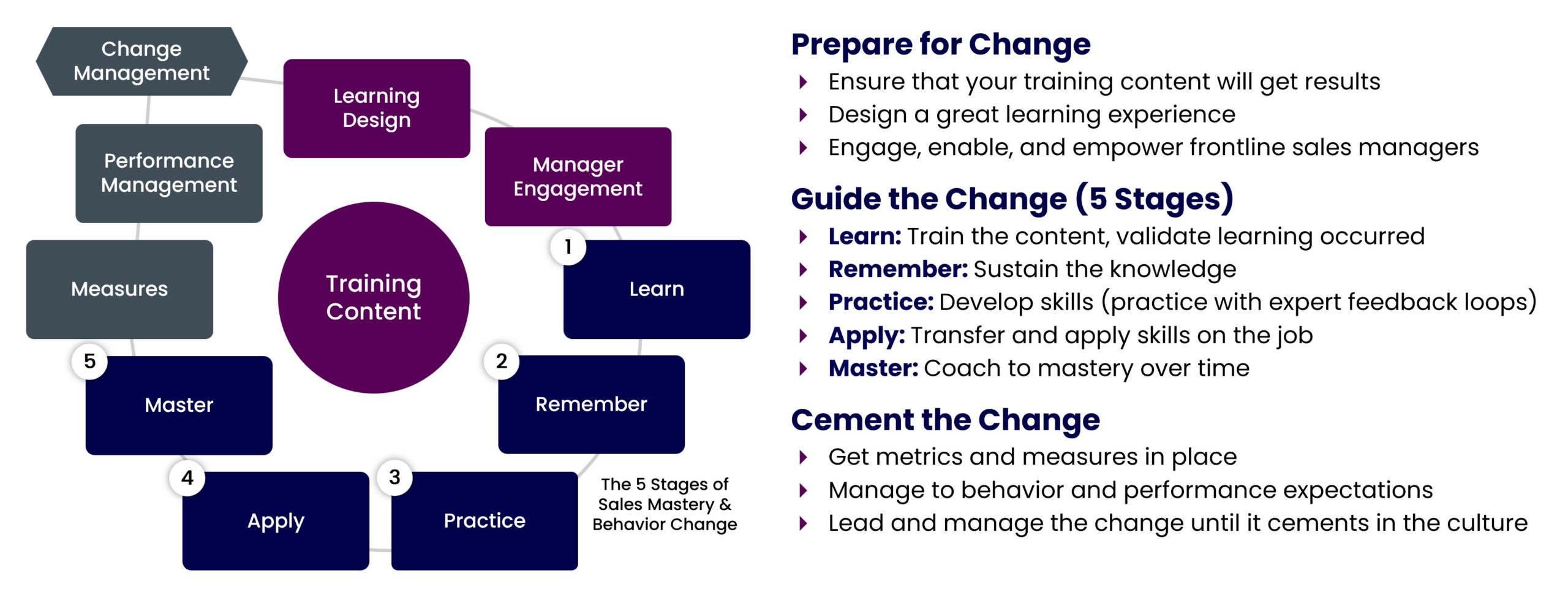
The failure of sales training to produce business results is almost legendary. It happens far too often. This leads to the incorrect thinking that “sales training doesn’t work.”
If done well, sales training works fine for what it’s designed to do. On any given sales topic, good training teaches:
- WHAT to do
- WHY do it
- Especially HOW to do it
- And possibly WHEN and/or WHERE to do it (if those nuances matter)
So, training – done well – provides the knowledge and skills required to do a task or job. It does hold tremendous potential to improve performance if employees haven’t mastered the tasks or job. This is particularly true for sales, where skills are complex, and mastery can significantly improve results. And, of course, that presumes you can get your employees to do what they’ve been taught.
As with any topic, knowing what to do and being able to do it are very different things. Simply teaching people does not automatically mean that the knowledge and skill will be used or used well. The “Knowing/Doing Gap” is legendary, too, and entire books have been written about it.
In this post, I’ll share why sales training commonly fails to deliver business results and what you can do to get the results you deserve for your talent investment.
To do this, though, you’ll need to accept an uncomfortable truth.

Let’s explore.
Common Reasons That Sales Training Fails
In over 35 years in the sales profession overall, with over 25 years in various performance improvement roles, I have seen very consistent patterns for why sales training fails.
Wrong Content: Build or buy a proven-effective sales methodology. Validate it against or customize it with top-performers practices. Ensure your front-line sales managers buy-in.
No Performance Milestones Set: Know what you’re trying to improve and why. (This should be clear before you build or buy training.) Establish benchmarks and set goals (performance milestones). Note: Setting performance goals for training is somewhat of an art, but if you compare average results to top-performer results, you can model out various scenarios. If you keep at it and are as data-driven as possible, you will improve your forecasting ability.
Poor Learning Design/Experience: It’s an oddity that everyone who knows something about anything feels qualified to design, develop and deliver training. If you’re building your curriculum: Hire or rent a professional instructional systems designer with a background in evidence-based methods and performance-based training design. If you’re selecting commercially available training: Ensure the content will work in your environment and then select someone who can explain the design principles behind their work and has a high degree of success guiding implementations.
No Knowledge Sustainment Plan: The “forgetting curve” is real and is well understood in the training/learning industry. Have a plan to keep the content alive and reinforce it to help it stick in long-term memory. Managers should follow up with their sellers, ask questions to validate understanding and incorporate training principles into team and one-on-one meetings.
Too Little Practice/Feedback: If you’re doing sales training, it’s likely very skill focused (or should be). Discomfort, conscious incompetence (when you know you’re not good at something you just learned), fear of embarrassment and fear of failure are strong demotivators that prevent people from using what they’ve learned. Providing deliberate practice (role play) with feedback loops (coaching) and opportunities to re-run the session (practice again, incorporating the feedback) can radically accelerate skill levels and develop comfort.
No Purposeful Transfer Plan: Even with the right content, great training design, a plan to help people remember, and practice and feedback sessions to build comfort, people still don’t always use what they learn in the real world. Providing support can help, in the form of job aids, cheat sheets, worksheets, tools and manager ride- or call-alongs, to encourage application (often called “training transfer” by learning professionals). The goal is to both encourage and make it easy for your sellers to use what they learned.
No Coaching to Mastery: Just because someone learned, remembered, practiced and applied a new skill, doesn’t mean they did it well or will continue to do it. This is where coaching comes in, and it is why you must engage, empower and enable your front-line sales managers (FLSMs). FLSMs are the single largest performance lever you have in your arsenal to guide change and help sales reps reach mastery.
No Measurement Plan: Build your plan from the “why” story and your Performance Milestones referenced above. Measure application and results post-training to gauge progress, pivot as needed and report results. I often recommend a “look-back” performance benchmark equal to the length of the average sales cycle (unless it’s very short, then double or triple it). Next, I freeze the month where training occurred and give people a chance to absorb and apply. Lastly, track sales performance for one to three times the length of the look-back period. Be prepared to see a slight dip in performance as people migrate to new skills and develop comfort and expertise. This is common. If you stay the course with reinforcement, support and coaching, results should rise with improved skill levels.
No Change Management Plan: Almost every sales training or sales enablement initiative or project is a change management project in disguise. Whether you use Lewin’s simple Unfreeze, Change, Refreeze model, Prosci’s ADKAR, Kotter’s 8-Step Model, the ACMP model or others listed here and here, the bottom-line is that you must guide the change and stick with it, until the new behaviors become “the way we do things around here.” When we quit too soon, before acculturating the change, the proverbial rubber band snaps back to its original shape, and you slowly lose any gains and return to previous ways of selling and former results.
I often see many of these challenges within a single training initiative. Is it any wonder we’re not getting better results?
The Association for Talent Development (formerly the American Society for Training & Development) conducts a sales training study every few years and publishes a State of Sales Training Report. I’m not sure why they didn’t continue to ask this question in subsequent years, but in 2016 and 2019, they asked respondents about the top barriers to sales training success. The results were concerning and enlightening: 59% of sales training and sales enablement leaders said the top barrier was that salespeople are not held accountable for applying skills learned in training.

These reasons and barriers provide the cues and clues we need to overcome this challenge and get better results.
The Sales Training System Puts It All Together
If you find yourself wondering if there is a model that can help you keep all of this in mind, wonder no more. I first crafted an early version of this model in 1994 but updated it significantly in 2003. It’s evolved over the years since then, and my terminology has changed with the times, but this model has been put through the test in multiple companies in multiple industries and has never failed me when I had the necessary support to implement it well.
Prepare for change:
- Ensure your training content will get results
- Design a great learning experience
- Engage, enable and empower frontline sales managers
Guide the change (5 stages):
- Learn: Train the content, validate learning occurred
- Remember: Sustain the knowledge
- Practice: Develop skills (practice with expert feedback loops)
- Apply: Transfer and apply skills on the job
- Master: Coach to mastery over time
Cement the change:
- Get metrics and measures in place
- Manage to behavior and performance expectations
- Lead and manage the change until it cements in the culture

Click here to view a larger image.
The model itself is not a full change model, because it doesn’t include the “why” story, building a coalition or other steps or strategies from the fuller change models mentioned above (and suggested in the “Change Management” box in this model). However, it does provide a clear path for implementing sales training effectively and getting outstanding results.
I hope you will find it as useful as I have.
Well, that’s it for this post. If it helps you in any way on your journey toward improved sales effectiveness, please feel free to let me know. I’d enjoy hearing about your successes.
Mike Kunkle is an internationally recognized expert on sales enablement, sales effectiveness, sales training, sales coaching, sales management, and sales transformations.
He’s spent over 30 years helping companies drive dramatic revenue growth through best-in-class enablement strategies and proven effective sales systems.
Mike is the founder of Transforming Sales Results, LLC where he designs sales training, delivers workshops, and helps clients improve sales results through a variety of sales effectiveness practices and advisory services.
He collaborated to develop SPARXiQ’s Modern Sales Foundations™ curriculum and authored their Sales Coaching Excellence™ and Sales Management Foundations™ courses.
Mike's book, The Building Blocks of Sales Enablement, is available on Amazon, with others coming soon in 2026, starting with The CoNavigator Method for B2B Selling.

